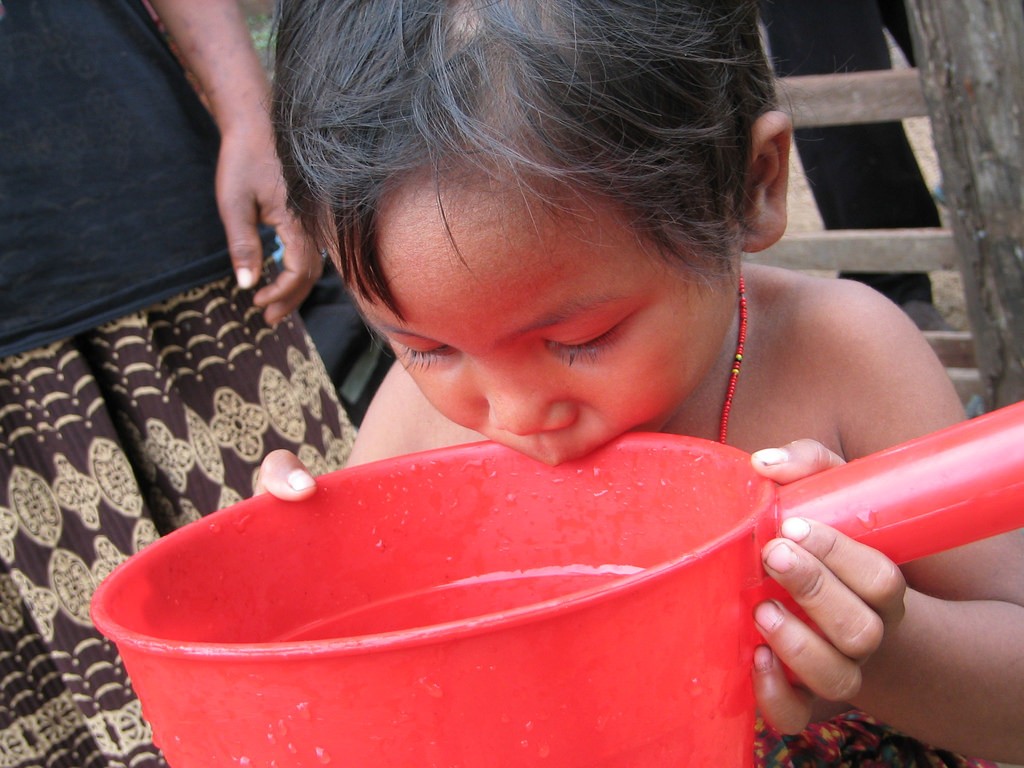
Young child drinks clean water in Cambodia. Photo by Cecilia Snyder, taken on 12 July 2003. Licensed under CC BY-NC-ND 2.0
Water pollution can be defined in many different ways. Basically, it is the contamination of water when pollutants are discharged into water bodies without treatment (removal of pollutants). Water pollution is largely caused by industrial, agricultural and household wastes which significantly affect human and animal health and the environmental quality of water bodies.
In Cambodia, access to safe and clean water remains a challenge, particularly for rural households as access to water facilities and infrastructure is limited outside the main cities.
Challenge of access to clean water
UNICEF found that 6.3 million out of 14.9 million Cambodians lack access to clean water.1 During the 2014 World Water Day, UNICEF Cambodia urged the government to put the rural water supply in greater focus. The organization said the main reason millions of Cambodians lack access to clean water is that the government has made the rural water supply a lesser priority than other development areas.2
Arsenic contamination was found in Cambodia’s drinking water during the Cambodia Drinking Water Quality Assessment, conducted jointly by the Ministry of Rural Development and the Ministry of Industry, Mines and Energy between 1999 and 2000.3 To tackle this issue, Ministry of Industry, Mines, and Energy approved Cambodian drinking water quality standards in 2004.4 For example, drinking water should not contain more than 0.05 mg of Arsenic per litre.5
Arsenic can be found naturally in the groundwater and Mekong River basin. Kandal, Prey Veng, Kampong Cham, Kampong Chhnang, Kampong Thom and Kratie provinces have some of the highest arsenic concentrations in the country.6 Amongst these, Kandal province has the most extreme arsenic pollution. In 2014, The Phnom Penh Post reported that 35% of more than 15,000 wells sampled in Kandal contained arsenic exceeding the national limit of 0.05 mg per litre, and around 54% measured above the WHO standard of 0.01 mg per litre.7
Directly or indirectly, water essentially keeps people and the environment healthy. Arsenic contamination would put millions of people at risk if no action were taken.
A UNICEF briefing found that arsenic exposure has already caused more than 500 documented cases of illness, and numerous amputations and fatalities.8
Laws and regulations
A Sub-Decree on Water Pollution was approved in 1999. The sub-decree states that the Ministry of Environment (MOE) has the roles and responsibilities to monitor, inspect and report on any potentially polluting activities. Companies or organisations discharging or transporting wastewater must request permits from MOE.9
The Sub-Decree on Water Pollution sets out two categories for water pollution sources:10
- Category I: must obtain a prior permit from MOE when the amount of their wastewater exceeds 10 m3 per day.
- Category II: must apply for permission from MOE before discharging or transporting their wastewater.
More than 60 types of pollution sources for all public or private projects are listed in an attached annex. This includes projects for food processing factories, agro-industrial processing factories, business centers, hotels, restaurants, hospitals and clinics, light and heavy manufacturing, wood and paper production, mining, chemical plants, textiles and power plants.11
However, recently local media have reported some emerging cases related to water pollution which are not yet well-monitored.
For example, in 2015, indigenous Kuy villagers from Thala Barivat district in Stung Treng province reported that a sawmill polluted their local waterway, which contaminated the water and crops and caused skin diseases. Radio Free Asia mentioned that wastewater was dumped into the stream which local people use for their daily needs including bathing, drinking, washing and cooking.12
Similarly, in early 2016, Pailin’s local cassava processing factories were pointed out as the cause of water pollution. The Phnom Penh Post reported that the waste from the plantations had killed fish and polluted drinking water and affected 300 families in Treng commune, Ratanak Mondul district, Battambang province.13 As a solution, the businesses built ponds near their production facilities to dump the waste and communities were forced to buy bottled water or build wells to use.14 However, to date, actions taken are not effective enough to tackle the pollution.
Last update: 29 February 2016
Related to water pollution
- Environmental and natural resources policy and administration
- Environmental and biodiversity protection
- Pollution and waste
References
- 1. Ouk, Savbory. “Nearly Half of Cambodians Lack Access to Safe Water.” Radio Free Asia, 21 March 2014. Accessed 23 February 2016. http://www.rfa.org/english/news/cambodia/unicef-water-03212014154522.html
- 2. Ibid.
- 3. UNICEF. “Arsenic in Cambodia”. Accessed 24 February 2016. http://www.unicef.org/cambodia/As_Mitigation_in_Cambodia_2009.pdf
- 4. Ministry of Industry, Mines and Energy. 2004. Drinking Water Quality Standards. Accessed 15 February 2016. http://rdic.org/wp-content/uploads/2014/12/MIME-Drinking-Water-Quality-Standards-2004-en.pdf
- 5. Ibid.
- 6. Ibid.
- 7. Barron, Laignee, and David Sen. “Silent Killer Taking Toll.” The Phnom Penh Post, March 19, 2014. Accessed February 24, 2016. http://www.phnompenhpost.com/national/silent-killer-taking-toll
- 8. Ibid.
- 9. Sub-Decree on Water Pollution. 1999. Article 10.
- 10. Sub-Decree on Water Pollution. 1999. Article 11.
- 11. Sub-Decree on Water Pollution. 1999. Annex 3.
- 12. Men, Sothy. “Villagers in Cambodia’s Stung Treng Say Waterway Contaminated by Local Saw Mill.” Radio Free Asia, 14 September 2015. Accessed 23 February 2016. http://www.rfa.org/english/news/cambodia/contamination-09142015173926.html
- 13. Morn, Vanntey. “Little Action Taken on Pailin Cassava Producers’ Pollution.” The Phnom Penh Post, 11 February 2016. Accessed 23 February 2016. http://www.phnompenhpost.com/national/little-action-taken-pailin-cassava-producers-pollution
- 14. Ibid.

